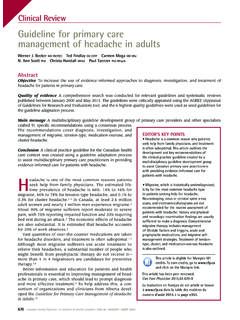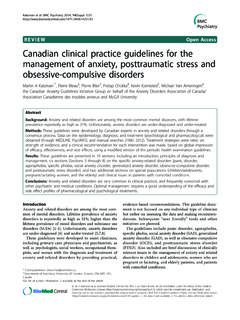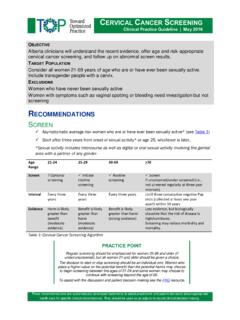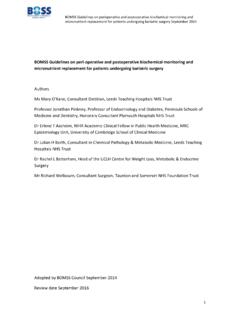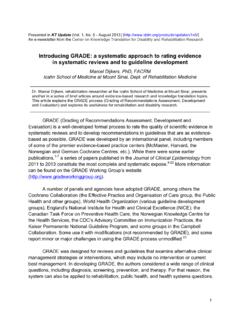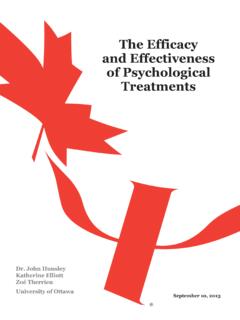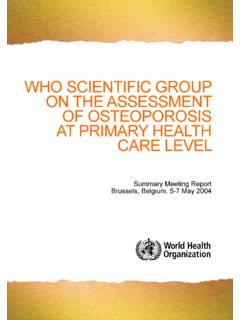Transcription of Simplified lipid guidelines - Canadian Family Physician
1 Vol 61: october octobre 2015 | Canadian Family Physician Le M decin de famille canadien 857 Simplified lipid guidelinesPrevention and management of cardiovascular disease in primary careG. Michael Allan MD CCFP Adrienne J. Lindblad ACPR PharmD Ann Comeau MN NP CCN(C) John Coppola MD CCFP Brianne Hudson MD CCFP Marco Mannarino MD CCFP Cindy McMinis Raj Padwal MD MSc Christine Schelstraete Kelly Zarnke MD MSc FRCPC Scott Garrison MD PhD CCFP Candra Cotton Christina Korownyk MD CCFP James McCormack PharmD Sharon Nickel Michael R. Kolber MD CCFP MScAbstractObjective To develop clinical practice guidelines for a Simplified approach to primary prevention of cardiovascular disease (CVD), concentrating on CVD risk estimation and lipid management for primary care clinicians and their teams; we sought increased contribution from primary care professionals with little or no conflict of interest and focused on the highest level of evidence available.
2 Methods Nine health professionals (4 Family physicians, 2 internal medicine specialists, 1 nurse practitioner, 1 registered nurse, and 1 pharmacist) and 1 nonvoting member (pharmacist project manager) comprised the overarching lipid Pathway Committee (LPC). Member selection was based on profession, practice setting, and location, and members disclosed any actual or potential conflicts of interest. The guideline process was iterative through online posting, detailed evidence review, and telephone and online meetings. The LPC identified 12 priority questions to be addressed.
3 The Evidence Review Group answered these questions. After review of the answers, key recommendations were derived through consensus of the LPC. The guidelines were drafted, refined, and distributed to a group of clinicians ( Family physicians, other specialists, pharmacists, nurses, and nurse practitioners) and patients for feedback, then refined again and finalized by the Recommendations are provided on screening and testing, risk assessments, interventions, follow-up, and the role of acetylsalicylic acid in primary These Simplified lipid guidelines provide practical recommendations for prevention and treatment of CVD for primary care practitioners.
4 All recommendations are intended to assist with, not dictate, decision making in conjunction with patients. Numerous clinical practice guidelines exist on managing dyslipidemia, sometimes with widely varying Adherence to and realization of these guide-lines in primary care is often Primary care uptake might be hampered by the limited involvement of primary care physi-cians (17% of contributors) in the development of national clini-cal practice It is also clear that many of the targets recommended in clinical practice guidelines are not attainable for most patients even in clinical trials designed specifically to address Furthermore, the amount of time required to adhere to chronic disease management and preventive care rec-ommendations might be ,10 Additionally, approxi-mately 50% of recommendations in guidelines are based on the lowest-level evidence (primarily expert opinion).
5 11,12 Although some level of expert opinion is reasonable, such a high percentage is EDITOR S KEY POINTS clinical practice guidelines are often developed with little input from the primary care practitioners who will be implementing the recommendations, and contributors to guideline development often have actual or potential conflicts of interest, many of which go undeclared. The process used to develop these guidelines aimed to include more primary care practitioners with little or no conflict of interest in order to create Simplified lipid guidelines that were relevant and easy to implement in primary care.
6 Patient input was also sought. The resulting guidelines provide an implementation algorithm and practical recommendations on screening and testing, risk assessments, interventions, follow-up, and the role of acetylsalicylic acid in primary prevention. Supplementary documents include a patient handout and the extensive evidence review that was completed to develop the article is eligible for Mainpro-M1 credits. To earn credits, go to and click on the Mainpro link. This article is eligible for Mainpro-M1 credits. To earn credits, go to and click on the Mainpro article has been peer reviewed.
7 Can Fam Physician 2015;61:857-67La traduction en fran ais de cet article se trouve dans la table des mati res du num ro d octobre 2015 la page Practice Guidelines858 Canadian Family Physician Le M decin de famille canadien | Vol 61: october octobre 2015 clinical Practice guidelines | Simplified lipid guidelines158 Canadian Family Physician Le M decin de famille canadien | Vol 61: october octobre 2015 clinical Practice GuidelinesRecommendations summaryScreening and testing Initiating screening: In patients without CVD (primary prevention), we suggest lipid testing as part of global CVD risk estimation in men at age 40 y and women at age 50 y (moderate-level evidence).
8 -Testing can be considered earlier for patients with known traditional CVD risk factors including, but not limited to, hypertension, Family history of premature CVD, diabetes, and smoking (low-level evidence). Repeat screening: For patients not taking lipid -lowering therapy, we suggest lipid testing as part of global CVD risk estimation, performed no more than every 5 y (moderate-level evidence). Global CVD risk estimation can be repeated sooner if other CVD risk factors develop in the interim. Patients do not need to fast for lipid testing.
9 Nonfasting lipid levels can be used to calculate global CVD risk (moderate-level evidence).Risk assessments Primary prevention: We encourage risk estimation with a CVD risk calculator (eg, Framingham) every time lipid testing is performed. Testing and risk estimation should be performed starting at age 40 y in men and 50 y in women (or earlier if indicated by other risk factors) until age 75 y (low-level evidence). -Primary prevention in patients with diabetes mellitus: We encourage risk estimation as above (low-level evidence).
10 -Primary prevention in patients with CKD: We recommend using a CVD risk calculator (eg, QRISK2) that includes CKD in its estimation of risk (low-level evidence). We discourage risk estimation for the following patients: -Those with pre-existing CVD, as they are automatically at high risk (high-level evidence). -Those < 40 y (without additional risk factors) and those > 75 y, as risk equations are not based on patients in these age ranges (low-level evidence). -Patients taking lipid therapy, as calculators are not designed to adjust for changes with lipid therapy (low-level evidence).



